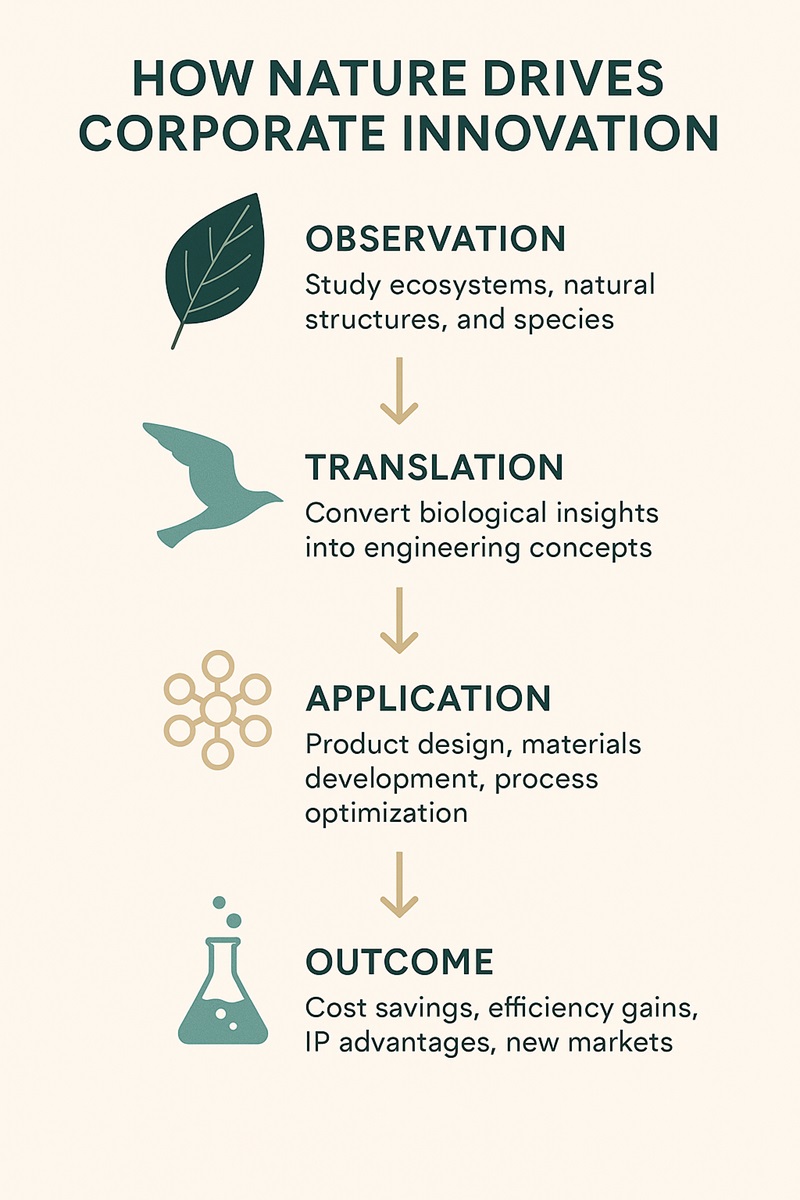Biodiversity is no longer just an environmental concern—it’s rapidly becoming a corporate innovation driver.
More than $44 trillion of global GDP depends on nature, and companies that study ecosystems are uncovering breakthroughs worth billions.
Companies rarely used to think of biodiversity as anything other than a scientific topic that lived in field reports and research journals. Now it keeps slipping into boardrooms because leaders are realizing that nature rich regions and the species within them keep inspiring ideas that drive new products, new materials, and entirely new sectors. It feels less like a trend and more like a long overdue correction, one that reminds business leaders that ecosystems quietly hold an enormous amount of economic potential when people take the time to study how things actually work outside a spreadsheet. The shift has come with a hopeful tone, since it gives companies fresh territory to explore without the pressure of reinventing their identity. They simply have to pay closer attention to the natural systems that have always been there.

Biodiversity And Business Creativity
Every industry has its version of the blank canvas problem, the moment when teams run out of ideas because the usual sources start recycling themselves. Many executives have discovered that biodiversity offers a way around that wall since ecosystems rarely repeat their own designs. Studying how plants adapt, how animals communicate, and how organisms build resilient structures keeps leading researchers to processes that translate into engineering insights or new types of materials. That kind of inspiration does not replace traditional research, it expands it. When a company learns to see a forest, a coral system, or even a patch of grassland as a library of functional patterns, the innovation pipeline tends to widen in ways that feel organic rather than forced. The payoff shows up in gradual improvements to products people recognize as well as entire lines born from fresh thinking supported by real world biology.
Biodiversity-Inspired Innovation in Action
Real-world examples prove the point:
Airbus “AlbatrossOne”
Inspired by the flexible wing tips of the albatross, Airbus developed a model that reduces drag and saves fuel—a breakthrough aviation had been chasing for years.
Shinkansen Bullet Train
Japan’s train engineers redesigned the front nose after studying the kingfisher’s beak, which slices into water with minimal splash. Result: a quieter, faster, more energy-efficient train.
Sharklet Technologies
Sharkskin micro-patterns inspired bacteria-resistant surfaces now used in healthcare, reducing infection risk without chemicals.
ECOncrete
Marine ecologists helped create concrete structures that mimic coral textures, encouraging marine life to grow while improving durability.
These aren’t niche examples—they’re signals of a deeper shift.
The Economic Value of Nature-Based Intelligence
The business case for biodiversity is no longer theoretical:
- $44 trillion of global GDP depends moderately or heavily on nature (World Economic Forum).
- The bioinspired materials market is projected to exceed $1.6 trillion by 2030.
- Companies using nature-based design often report 10–50% efficiency improvements in material use or energy savings.
- Nature-tech startups raised an estimated $7–9 billion in 2023, a number climbing annually.
When executives see these numbers, biodiversity becomes business strategy—not sentiment.
New Talent Pathways Emerging Through Biodiversity Work
There is another business angle that keeps rising to the surface. As more companies explore natural systems, they find themselves needing people who can translate field knowledge into commercial applications. That creates opportunities for scientists, engineers, and analysts who might not have pictured themselves in a corporate setting. It also expands hiring conversations into disciplines that rarely interact, which supports diversifying the US workforce in a way that feels grounded in genuine need rather than a slogan. Marine biologists end up sitting next to materials chemists. Botanists bounce ideas off product designers. These unexpected combinations tend to produce surprisingly strong outcomes because no one arrives with the same assumptions. Once a company gets used to this pattern, the door opens wider for unconventional career paths that strengthen the creative core of the business.
Regional Biodiversity As A Growth Asset
Some executives have begun looking at biodiversity rich regions as strategic partners rather than remote destinations. When a company sets up a research hub or collaborates with local experts, it gains access to knowledge that would be impossible to recreate in a lab alone. The relationship goes both ways. Local communities benefit when companies treat natural assets with respect and recognize the value of expertise that already exists on the ground. A company might learn from a team that spends half its time in wetlands or forests and uses their findings to improve existing products. That kind of cooperation turns regional biodiversity into a business advantage without turning it into a commodity. It simply acknowledges that nature has been refining its own systems for far longer than any human invented model.
Partnerships Taking Shape Around Biodiversity
Some organizations have started forming careful collaborations with research groups, universities, and field teams who understand specific ecosystems. In certain cases, companies find themselves working with an environmental nonprofit organization if necessary to gain access to data that would never show up through traditional channels. These partnerships often grow naturally because both sides want outcomes that support long term understanding rather than short term gain. It becomes easier to experiment, test ideas, and evaluate results when commercial urgency does not overshadow scientific clarity. Businesses that pursue these collaborations tend to create products rooted in real biological insight, which builds credibility and sharpens competitive edge at the same time. Over time, these relationships form a quiet network of shared knowledge that benefits multiple sectors.
Investors Are Reassessing Nature Based Intelligence
Investors rarely overlook new sources of innovation once they prove valuable. The recent interest in biodiversity driven research reflects that instinct. When a company shows that a botanical structure inspired a more efficient material or that a marine organism influenced a new design, investors start paying attention because the business case becomes clear. They are not responding to sentiment. They are responding to the idea that nature holds an immense amount of underused intellectual capital. This shift encourages companies to treat natural systems as an ongoing source of intelligence rather than a single research project. The long view tends to stabilize investment decisions and helps shape a pipeline that feels sturdy even in fast changing markets.
Ecosystem Innovation Hotspots to Watch
Different ecosystems specialize in different types of intelligence:
- Tropical forests: biomaterials, regenerative agriculture, carbon-efficient structures
- Coral reefs: hydrodynamics, antifouling technologies, surface engineering
- Arctic biomes: insulation, cold-weather machinery, adaptive transport
- Grasslands: water efficiency, drought-resilient design, root-based infrastructure
Companies that deliberately seek out these “innovation hotspots” often leapfrog competitors stuck in conventional R&D cycles.
How Companies Can Build a Biodiversity Innovation Pipeline
Businesses ready to integrate nature-based insight can start with a simple framework:
1. Identify ecosystems relevant to your industry
Do you need new materials? Look to forests. Fluid engineering? Study marine organisms.
2. Create cross-disciplinary teams
Pair engineers with biologists, product designers with ecologists.
3. Build ethical research partnerships
Work with universities, field teams, Indigenous groups, and conservation organizations.
4. Set benefit-sharing rules
Ensure local communities and knowledge holders are compensated and credited.
5. Integrate biological insights into product roadmaps
Treat nature as a recurring research input—not a one-off project.
Companies following this model report faster R&D cycles and innovations that feel more intuitive to customers.
Ethical and Legal Considerations: Avoiding Biopiracy
Nature can’t be a free extraction zone. Companies must navigate:
- Nagoya Protocol requirements
- fair compensation for Indigenous knowledge
- ethical biological sampling
- transparent data-sharing agreements
- IP challenges when nature inspires a design
Handling these issues responsibly builds trust and prevents reputational damage.
The Rise of Nature-Positive Corporate Standards
Biodiversity is also entering regulatory frameworks, pushing companies to act more transparently. Key standards include:
- TNFD (Taskforce on Nature-Related Financial Disclosures)
- SBTN (Science Based Targets for Nature)
- The Global Biodiversity Framework (Target 15)
- CSRD biodiversity reporting requirements in the EU
These frameworks elevate biodiversity to the level of climate disclosures and financial risk management.
Investor Momentum: Why Wall Street Is Paying Attention
For years, investors saw biodiversity as a soft ESG topic. It sat on the side and did not shape real strategy. That has changed. Today, big investors see biodiversity as a strong source of profit and a real edge in the market.
Why the shift? Clear results.
More companies can now prove that nature-based ideas work. Bio-inspired materials lower costs, cut waste, and often perform better than older options. Nature-tech startups are also growing fast. They create smarter materials, cleaner energy tools, and systems that help protect supply chains over time. These companies also build IP that is hard to copy. This gives them strong protection and long-term value.
In simple terms, Wall Street is not buying into hype or green slogans. Investors are reacting to a clear trend. Nature-driven innovation is becoming a strong and often overlooked driver of real growth. This is not ESG for show. It is a strategy backed by proof, returns, and serious economic upside.
Challenges and Limitations: The Realistic View
While promising, biodiversity-led innovation comes with challenges:
- insights can’t always be scaled quickly
- biological research takes time
- IP rights may be complex
- partnerships may require capacity-building
- ecosystems can be unpredictable
But these hurdles are manageable—and far outweighed by the upside.
Future Trends: Where Nature-Inspired Innovation Is Heading
The last decade showed us that nature can help solve big problems. The next decade will show how much more it can do. New trends are already here, and they point to a major shift in how we design, build, and run our world.
One fast-growing area is bio-made materials. Mycelium leather, algae foam, and other nature-based products are moving from labs to real factories. They use less energy, create less waste, and often work as well as, or better than, synthetic materials. At the same time, AI tools now help experts study ecosystems in far less time. This means scientists can make new discoveries much faster.
Investors also see the rise of nature-tech startups. These young companies fix supply-chain issues, build low-carbon materials, and develop smarter tools for tracking the environment. There is also growing interest in regenerative systems, which copy natural cycles instead of breaking them. These systems help companies cut waste, save resources, and build long-term strength.
Even fields like robotics and infrastructure are changing. Engineers are studying coral shapes, insect movement, and other natural designs to build machines and structures that can adapt, recover, and work more efficiently.
All of these trends point to one clear idea: nature-inspired innovation will guide the next wave of industrial change. The companies that move early will set the standard for everyone else.
Biodiversity has turned into a reliable wellspring for leaders who want innovation grounded in something real. It offers companies a way to push forward without drifting into abstraction, and it reminds decision makers that some of the smartest design solutions are already functioning out in the world. Businesses that build thoughtful relationships with ecological knowledge often find themselves developing ideas that feel genuinely new rather than recycled. The momentum is likely to continue, since the natural world rarely runs out of surprises.




